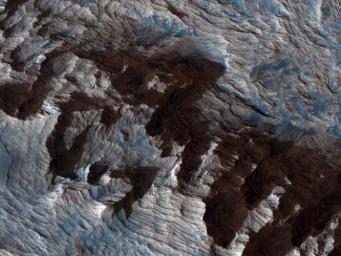
|
Layered Bedrock in Candor Chasma
- Click the image above for a larger view
- Full-Res JPEG (2560 x 1920) (831.1 kB)
- Full-Res TIFF (2560 x 1920) (14.8 MB)
Caption:
This image shows an area of layered deposits in Candor Chasma. Here, sheets and dunes of dark-toned sand cover the light-toned, layered bedrock. Accumulations of dark sand accentuate bedding within the light-toned bedrock, giving some areas a zebra striped pattern.
In the Northern part of the scene, the bedrock has been eroded into steep, craggy cliffs. Some sections of these cliffs are covered by triangular-shaped debris fans that are intermediate in color between the dark-toned sand and light-toned bedrock.These fans may contain a mix of light-toned bedrock that has crumbled away from the surrounding cliffs and wind-blown sand and dust.
The surfaces of some fans are dissected by gullies, which most likely formed through dry avalanching. The bottoms of the gully channels are often darker in tone than the surrounding fan surface. This may be due to accumulations of wind-blown sand in the gully floor. The subimage shows a clear example of a gullied fan from the northern portion of the scene.
Originally released October 10, 2007
Background Info:
NASA's Jet Propulsion Laboratory, a division of the California Institute of Technology in Pasadena, manages the Mars Reconnaissance Orbiter for NASA's Science Mission Directorate, Washington. Lockheed Martin Space Systems, Denver, built the spacecraft. The High Resolution Imaging Science Experiment is operated by the University of Arizona, Tucson, and the instrument was built by Ball Aerospace & Technologies Corp., Boulder, Colo.
Cataloging Keywords:
| Name | Value | Additional Values |
|---|---|---|
| Target | Mars | |
| System | ||
| Target Type | Planet | |
| Mission | Mars Reconnaissance Orbiter (MRO) | |
| Instrument Host | Mars Reconnaissance Orbiter | |
| Host Type | Orbiter | |
| Instrument | High Resolution Imaging Science Experiment (HiRISE) | |
| Detector | ||
| Extra Keywords | Color, Dune, Dust | |
| Acquisition Date | ||
| Release Date | 2011-01-05 | |
| Date in Caption | 2007-10-10 | |
| Image Credit | NASA/JPL-Caltech/University of Arizona | |
| Source | photojournal.jpl.nasa.gov/catalog/PIA13725 | |
| Identifier | PIA13725 | |
